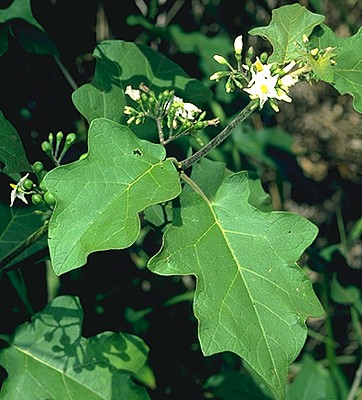 Near Calen, QLD. Photo: T. Low © T. Low |
 Maroochy, Qld. Photo: G. Leiper © G. Leiper |
 Copyright free image by Forest & Kim Starr from Plants of Hawaii site. |
 Line drawing by M. Szent Ivany J. Adelaide Bot. Gard. 4 (1981) 115, fig. 36. |
 From Rendle's 1938 The classification of flowering plants. |
 Distribution map generated from Australia's Virtual Herbarium. |

Synonymy
*Solanum torvum Sw., Nov. Gen. Sp. Pl. Prodr. 47 (1788)
T:
S. largiflorum C.White,
T: Kin Kin, Qld, Mar. 1916, C.T. White & W.D. Francis s.n.; syn: MEL, NSW.
Description
Spreading or scrambling shrub to 3 m, dark green, pubescent with stellate hairs; hairs dense on lower leaf-surface, sparser on upper surface; glandular hairs on pedicels; prickles 3–7 mm long, scattered on stems and leaf-surfaces, sparse to absent on mature growth.
Leaves broadly oval-ovate; lamina mostly 10–15 cm long, 8–10 cm wide, discolorous, lobed; lobes broadly triangular; petiole usually 2–5 cm long.
Inflorescence usually branched, 50–100–flowered, the upper and late-season flowers often male; peduncle to first fork 10–25 mm long; pedicels 5–10 mm long, slightly longer in fruit. Calyx 3–5 mm long; lobes apiculate, 2–3 mm long. Corolla stellate, deeply incised, 20–25 mm diam., white. Anthers 5–7.5 mm long.
Berry globular, 10–15 mm diam., drab yellow, drying black. Seeds 1.5–2 mm long, yellow or drab brown. n=24.
A more complete description can be found in Bean's treatment of the eastern Australian species at http://delta-intkey.com/solanum/www/torvum.htm
Distribution and ecology
Native to the West Indies, now a weed in tropical areas of many countries.
Naturalised along coastline of eastern Qld in disturbed areas and also occurring sporadically in the northern areas of NT and WA.
Common name
Devils Fig, Turkeyberry (US).
Relationships
Michael Nee (NY) has made the comment on specimens of S. chrysotrichum in AD that the material of S. hispidum from Costa Rica and Panama is a complex of species of southern Central America and NW Panama, not fully resolved in Flora of Panama (see also Solanaceae Source for a discussion of this).
The complex involves S. chrysotrichum, S. torvum, both present in Australia, and S. pluviale.
S. chrysotrichum and S. torvum are both considered by Bean (2004) to belong to the S. torvum group of subg. Leptostemonum. Levin (2006) also assigned them to the Torvum clade (see Solanaceae Source).
Notes
A noxious weed in Qld. Suspected of poisoning stock. However young fruits are eaten, raw or cooked, in south-east
Observations concerning the length of the style in flowers of this species were made by Hossain in 1973. The production of two lengths of style dependent on where a flower is in the inflorescence have implications for effective pollination in this species which is usually self-pollinated.
Reference: Hossain M. 1973 Observations on stylar heteromorphism in Solanum torvum Sw. (Solanaceae). Botanical Journal of the Linnean Society 66: 291-301.
Selected specimens
WA: Quarantine Cattle Yards, 13.5 km from Kununurra PO, Apr 2001, A.A.Mitchell 6694 (AD, PERTH); NT: Berrimah Farm, Feb 1981, M.Rankin 2582 (BRI, CANB, DNA); Qld: 36 km S of Cooktown, C.H. Gittins 2169 (NSW); 20 km S of Mackay, T.J. McDonald & G.N. Batianoff 1804 (BRI); near Helenvale, V.K. Moriarty 1094 (CANB); near Euramo, D.E. Symon 4744 (AD).
Plant status, if any
S. torvum is declared noxious in various parts of Queensland e.g. see Brisbane City Council at www.brisbane.qld.gov.au/BCC:BASE::pc=PC_2090 or City of Rockhampton where it is a priority pest plant www.rockhampton.qld.gov.au/CHP/PDF/Health&EnvironmentProfileC.pdf
S. torvum is not to be grown in school grounds in the Northern Territory because of its weed potential - see www.det.nt.gov.au/education/policiesandforms/
From the web
There is access to images through Bean's treatment of S. torvum at http://delta-intkey.com/solanum/www/torvum.htm
A photograph of this species can be seen on the Terania Rainforest Publishing Photo Library site and another, together with an herbarium specimen, on the
A very large selection of images of S. torvum is available through the Plants of Hawaii page with further information on the Pacific Island Ecosystems at Risk (PIER) site.
Background information on this species as a noxious weed can be found on the Federal Noxious Weed Disseminules of the United States and through the Plants Profile site of the US Department of Agriculture.
A comprehensive fact sheet on S. torvum in
There is presently limited information for this species on the Solanaceae Source site.